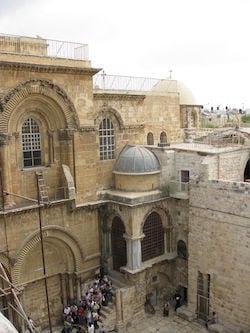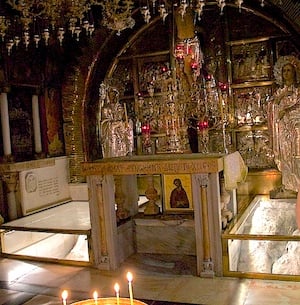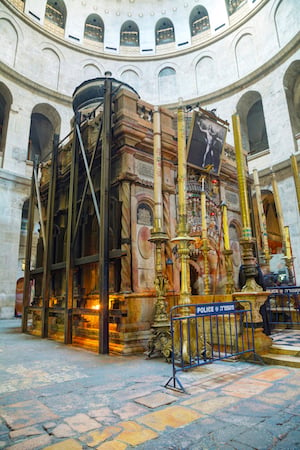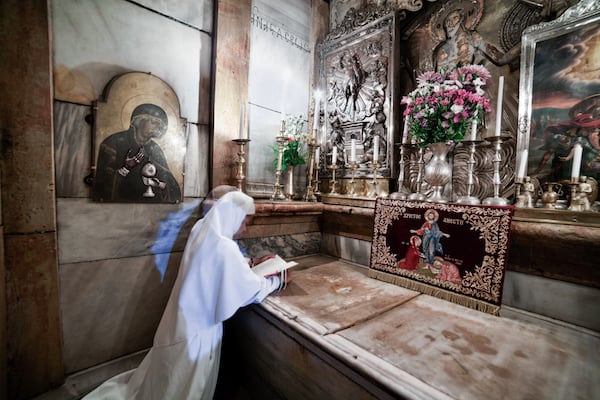The Holy Sepulcher
Golgotha: Place of the Crucifixion
The Church of the Holy Sepulcher is perhaps better named by Orthodox Christians, who call it the Church of the Anastasis (Resurrection). It is the church in Jerusalem that covers the tomb where Jesus was buried and from which he rose again. That church also holds the rock on which Jesus was crucified.
Scripture notes that the crucifixion site and the tomb were very close together: “Now in the place where he had been crucified there was a garden, and in the garden a new tomb, in which no one had yet been buried. So they laid Jesus there because of the Jewish preparation day; for the tomb was close by” (Jn 19:41-42).
The place of the crucifixion and burial was just outside of Jerusalem’s walls, but an expansion of those walls shortly after Jesus’ death and resurrection enclosed it within the city limits. Up until the year 66, the Christian community in Jerusalem gathered at this site for prayer. Roman authorities built a temple on the site in 135, perhaps as a way to discourage Christians, but the community continued to remember the place. (This schematic from National Geographic is a good reference point for visualizing the place.)
When Helen came to the Holy Land in 326-328 to find places associated with Jesus, she uncovered this site with the help of locals. They must have been certain that this was the place where Jesus was crucified, buried, and resurrected because it was inconvenient to tear down the temple complex—and very expensive.
When they removed the temple, Helen found the site to be just as the local community had remembered, and as Scripture records—there was a rock prominence that would have been the place of crucifixion, and a rock tomb nearby where Jesus’ body was laid. She found the cross of Christ discarded in an old cistern—a finding that is still celebrated in the Church with a feast day every September 14. She ordered workers to build a church over the site to enclose both Golgotha and the tomb.

Over the course of history, the church was completely destroyed and rebuilt a number of times (in fact, it was the desecration of this very place that instigated Europeans to respond with the crusades). What is left today is a real hodge-podge of a church, but scholars have much confidence that this is the place where these events happened. That can’t be said with such certainty about many of the sacred sites in the Holy Land.
As with the Church of the Nativity, custody of this church is shared between several different denominations. Clergy here guard their time and space jealously—fights have even broken out over small infringements. It is a disjointed place, and its brokenness is only highlighted by the lack of architectural harmony. It feels empty and dark, but that is not entirely inappropriate for the place where Jesus was crucified.
In Jesus’ time, just outside of Jerusalem was a quarry where workers from previous generations had mined limestone for the Temple and city walls. In the middle of the quarry was a raised mound, left there when the workers found a seam of bad rock unsuitable for building. They extracted stone from around that spot, leaving a white, round outcropping of limestone that looked like the top of a human skull. This illustration is useful to see the approximate layout of this area in relation to Jerusalem.
The quarry was near a major road leading through a gate to the city, so Romans used that mound as a place for crucifixions—criminals were executed there in a very public display so as to serve as an example. Crosses were placed low in the ground so that passersby could approach them and mock the crucified to their faces.
The Hebrew term for the place is Golgotha; “place of the skull” translated into Latin is Calvariæ Locus, which became “Calvary” in English. Both Calvary and Golgotha refer to the same spot.
So they took Jesus, and carrying the cross himself he went out to what is called the Place of the Skull, in Hebrew, Golgotha. There they crucified him, and with him two others, one on either side, with Jesus in the middle. (John 19:17-18)
The stone the builders rejected has become the cornerstone.(Ps 118:22)


As pilgrims enter the Church of the Holy Sepulcher, they ascend a staircase to go up one story to the chapel that encloses the rock outcropping upon which Jesus was crucified. The limestone where the two thieves were crucified is encased in glass (as in this photo), and the place in the center that would have held Jesus’ cross is covered by an altar.
To reverence this place, pilgrims may approach and kneel before the place of the cross. Like the place of the Nativity, there is a marble slab with a metal plate covering a small opening. You can place your hand inside this opening and reach down more than a foot to touch the rock that held the cross. Some pilgrims leave items there such as notes or symbols—it is a fruitful exercise to contemplate what people might have placed at the foot of the cross, and why.
What would you leave there?
Sepulcher: Place of Burial and Resurrection
At the time of Jesus’ crucifixion, the stone quarry just outside of the city walls that left the “place of the skull” was out of use, and the elements filled in the area with dirt and vegetation, which is why Scripture notes it as a garden.
Joseph of Arimathea was a wealthy follower of Jesus, and had just hewn a new family tomb in this garden (Jn 19:41). Because the Sabbath was approaching, they needed to dispose of Jesus’ body before sundown, so they used this tomb. It is only about 30 yards from the place of the crucifixion.
At the time, burial practices dictated that the body be wrapped in linen and anointed with oil. This would have been done in an antechamber of the tomb, and carved into the walls of this room would have been cavities in which bodies were placed. Families would prepare the bodies of loved ones by wrapping and anointing them, then they sealed up the tomb and antechamber with a stone to let the body decompose. After several years, they would return to remove the bones, still wrapped in linen, dispose of them, and reuse the tomb for a different family member who had died.
This video shows a model of this kind of tomb. (Note: this is a reproduction, not the actual tomb Jesus was buried in.) In it you can see the rock that would have sealed the tomb, the antechamber, and the smaller cavities that would have held dead bodies as they decomposed. Jesus’ tomb would have differed in that his body was placed on a bench or shelf parallel to the wall, not a separate body chamber, but the idea is the same.
Scripture records Joseph placing Jesus’ body in the tomb (Mt 27:59-60), but they did not have time to anoint his body, as was customary. This explains why Mary Magdalene and other women went to the tomb later—after the Sabbath—to perform this function, only to find the tomb empty (Mt 28, Mk 16, Lk 24).
When Helen had a church built over this site, workers stripped away extra rock, including the stone that would have formed the walls of the tomb, and enclosed the sites with a chapel over the crucifixion site and a small shrine over the burial and resurrection site. A large church was built over the top of both of these places. (This video shows the architecture of this location in its different incarnations through history.)


The chapel enclosing the place of the tomb (pictured here) is called the “edicule,” which is a Roman term for a small shrine. Though the walls of the tomb were stripped away during construction, and later invasions destroyed the slab upon which Jesus’ body laid, the place itself was preserved. The current edicule was constructed in 1810 after a fire, and it reproduces the antechamber and the shelf-like slab upon which Jesus’ body would have been laid in the inner tomb. It has a large iron skeleton around it because it is in dire need of repairs, which are just now beginning. In fact, the restoration has given archeologists a rare opportunity to look beneath the slab on which Jesus’ body rested, and to confirm it as the location that was discovered by Helen. (See inside the tomb with this video.)
There is usually a line of pilgrims waiting to enter the edicule to see the tomb, and the crowd creates something of a holy chaos with their jostling and maneuvering, not unlike the lines to see the place of the Nativity. It is a place of great reverence and holiness, and also a place crammed full of humanity.
Pilgrims entering the edicule must stoop to pass into its antechamber. Only a few candles illuminate the darkness within. The antechamber could hold maybe ten people—it is known as the Chapel of the Angel because it is where the angel appeared to Mary Magdalene when she was looking for Jesus’ body.
To enter the tomb, which is within the Chapel of the Angels, pilgrims must make a profound bow to pass through an even smaller entrance. Only four people can fit inside of that inner tomb at once—it feels much like entering a closet. On the right stands a marble slab, about knee high, with a marble altar behind it. Pilgrims have 15-20 seconds there before they must make room for others.
The marble slab feels smooth, worn, cool, and flat—it is a place to hold a body, but it is markedly empty. One is struck with the impression that this is where hope comes from—this is the place of our hope that death is not the end for us and for those we love.
Pilgrims moving from the streets of Jerusalem into the church, into the edicule, into the antechamber, and finally into the tomb experience successively smaller spaces. One’s field of vision is increasingly narrowed to the point that even light itself is removed until we find ourselves with only a few other faithful in an empty tomb looking at nothing but evidence of new life.



